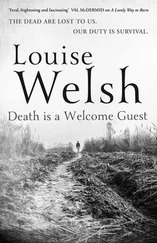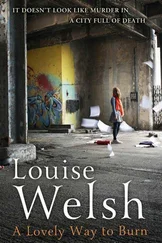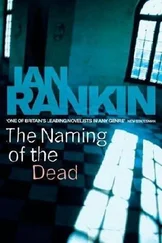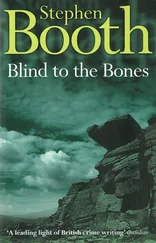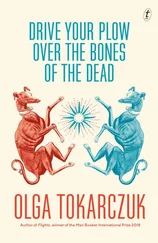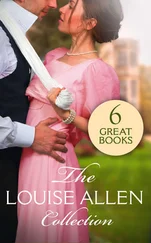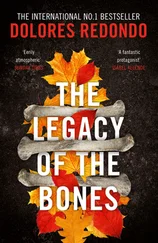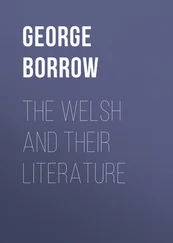Louise Welsh - Naming the Bones
Здесь есть возможность читать онлайн «Louise Welsh - Naming the Bones» весь текст электронной книги совершенно бесплатно (целиком полную версию без сокращений). В некоторых случаях можно слушать аудио, скачать через торрент в формате fb2 и присутствует краткое содержание. Год выпуска: 2011, Издательство: Canongate Books, Жанр: Современная проза, на английском языке. Описание произведения, (предисловие) а так же отзывы посетителей доступны на портале библиотеки ЛибКат.
- Название:Naming the Bones
- Автор:
- Издательство:Canongate Books
- Жанр:
- Год:2011
- ISBN:нет данных
- Рейтинг книги:4 / 5. Голосов: 1
-
Избранное:Добавить в избранное
- Отзывы:
-
Ваша оценка:
- 80
- 1
- 2
- 3
- 4
- 5
Naming the Bones: краткое содержание, описание и аннотация
Предлагаем к чтению аннотацию, описание, краткое содержание или предисловие (зависит от того, что написал сам автор книги «Naming the Bones»). Если вы не нашли необходимую информацию о книге — напишите в комментариях, мы постараемся отыскать её.
Naming the Bones — читать онлайн бесплатно полную книгу (весь текст) целиком
Ниже представлен текст книги, разбитый по страницам. Система сохранения места последней прочитанной страницы, позволяет с удобством читать онлайн бесплатно книгу «Naming the Bones», без необходимости каждый раз заново искать на чём Вы остановились. Поставьте закладку, и сможете в любой момент перейти на страницу, на которой закончили чтение.
Интервал:
Закладка:
The woman stopped, adjusted her scarf and then turned to look back at the chapel, as if searching the sky for evidence that the deed was done. Now was his chance. Murray stepped purposefully forward, his feet crunching on the gravel.
Green eyes flecked with amber flickered towards him. Murray meant to continue on, extend his hand and offer his condolences, but he stalled. The woman’s eyes glanced him up and down, then dismissed him. She turned, walked to a red Cherokee and got in, slamming the door.
Murray breathed out. He felt like a mouse that had frozen in the beam of a night owl’s reconnaissance flight, only to be inexplicably spared. He watched as the woman he was almost sure was Christie Graves drove down towards the gates of the crematorium and away.
Chapter Sixteen
SOMEWHERE ABOVE HIM Murray’s father was smiling as he told Jack all about his two wee boys. Murray quickly surveyed the Fruitmarket Gallery’s café and bookshop, and then asked a young attendant if Jack Watson was around.
‘Jack who?’
The boy was heroin-chic pale, dressed in shrink-tight black jeans and a too-big studded belt. He glanced Murray up and down, then looked away, as if he had seen enough.
‘Watson, he’s one of your exhibitors.’
The boy pulled a leaflet wearily from the plastic holder on the wall beside him and flicked it open.
‘Six o’clock.’
It had been a long day, punctuated by disappointment and cremation. Murray marshalled his patience.
‘What happens at six o’clock?’
All the weary weight of time was in the boy’s voice.
‘Jack Watson’s artist’s talk.’
Murray wondered if the date of the talk had been stored somewhere in his unconscious, the better part of him making moves towards reconciliation his sour consciousness couldn’t concede.
He glanced at his watch. There was an hour before Jack was due to speak. He wouldn’t stay to hear him talk about how their father’s illness had inspired his art — the very thought of it invoked a burr of impatience — but if he could catch him beforehand perhaps they could grab a pint together and patch things up.
‘If you see him, will you tell him his brother’s here, please?’
The boy leaned against the wall, his eyes trained on something beyond Murray’s view.
‘Sure.’
He made the prospect sound as likely as world peace.
The same Manga cartoons he and Jack had made fun of the last time they’d met still dominated the first room of the ground-floor gallery. The colours were still bubblegum bright, the bug-eyed girl still surprised by the spotty dog’s attentions. But now their devastated backgrounds seemed to dominate the image. He felt a sudden kinship with the citizens of Nagasaki who had crawled from the matchstick remains of their homes to find their city gone. Did they wake believing themselves dead? And when they realised the truth, how many committed suicide and regained blessed oblivion?
He had been wrong to laugh. Murray wasn’t sure if the artist was suggesting the H-bomb had led to a coarsening of culture, or that cartoons and pornography were destructive forces on society, but he was sure they viewed the world as a lost cause.
‘A cesspool.’
The words came out in a whisper, but he glanced round guiltily as he made his way to Cressida Reeves’ exhibition space, relieved there had been no one there to overhear him.
Perhaps it was the dust of Seafield cemetery still clinging to his soles that made the dim-lit room seem like a tomb. Or maybe it was the hundreds of faces staring from the walls, like supplications for healing from a saint who needed to be reminded what the sufferer looked like before intervening.
Murray began at what he assumed was the beginning: a cluster of baby photographs, children with cleft palates smiling delightedly for the camera. Some had clearly been taken in hospital, clinical assessments prior to operations, he supposed. But most were the usual bare-bum-on-fluffy-rug style of baby portrait. The distorted grins shone cheerfully beneath bright, fun-filled eyes. Murray felt ashamed by his own quick stab of revulsion at the warped lips and wet gums.
The next grouping was composed of children’s birthday parties. There was no sign of the cleft palates now. Murray wondered if they were the same subjects post-surgery, but other visitors entered the gallery and he resisted the temptation to scrutinise the beaming faces too closely.
The sets of photos continued through children’s calendar days: the opening of Christmas presents, first day of school, teenage friends. The samples were becoming smaller, some of the faces beginning to repeat. Murray returned to the information board he’d snubbed on the way in.
Cressida Reeves’ work is concerned with anonymity, identity and rites of passage. In her installation, Now You See Me , commissioned by the Fruitmarket Gallery, Reeves begins by inserting a baby photograph of herself into an anonymous sample of one hundred children also born with a cleft palate or ‘hare lip’. The condition is absent from succeeding groupings, reflecting the ease with which it is corrected. Each subsequent set relates a shared experience; birthday parties, Christmas mornings, first day at school, teenage discos, first love, college etc. Reeves includes increasing numbers of images of her friends and family in each set, until she is no longer an anonymous disfigured child surrounded by other equally anonymous infants, but an adult surrounded by people she has chosen to know.
He went back to the birthday photos, wondering if he could identify Cressida in amongst the excited children. The images were simple, snaps executed with no great skill, meaningless beyond their family group. But they might be amongst the first possessions people grabbed if their house were burning, the belongings they mourned most in a flood.
The sitting room wallpaper in his childhood home had been bold and brown, like the wallpaper on the photo he was looking at now. He remembered some of the toys the children were playing with too. A Christmas morning shot showed a little boy stripping the wrapping from a Transformer Jack had coveted. A toddler in kung-fu pyjamas posed military-style with a light sabre. Murray remembered him and Jack jumping around their shared bedroom, swinging the glowing, plastic sticks, battling for the right to be Han Solo. He would remind Jack of the light sabres later. And maybe sometime much later they would sort through some photos together. It was time.
Murray skipped the first days at school, and the school-uniformed shots that followed, and went directly to the teenage years. Now he could spot Cressida amongst the crowding faces. The ribbons coiled in her long hair, and the black fedora that topped the arrangement, declared her a fan of Boy George. That made her younger than Murray, but only by a few years.
He could see the tiny scar, faintly visible beneath the thick make-up. It had very likely tormented her through her teens, but it was already adding character to features that might otherwise have been too sweet for substance. How would it feel to kiss her there, on the slight pucker above her top lip? He walked swiftly to the college shots that comprised the next section, feeling ashamed of the sudden spark of desire that had transferred itself from grown-up Cressida to her teenage counterpart.
The art school crowd that she’d hung around with later looked edgier and more fashion-conscious than he supposed he and his university friends had, but Murray could still relate to the camaraderie in the images. He was searching for his brother’s face too now, and found him, beer bottle tilted to his mouth, hair gelled into a DA, the collar of his leather jacket turned up.
Murray smiled, recalling his father’s outrage when Jack had borrowed his car and driven it over the squeaky new leather jacket to scuff it up. It had looked good when he’d finished, though, a montage of monkeys, skulls and roses painted in red and black over the grazed surface.
Читать дальшеИнтервал:
Закладка:
Похожие книги на «Naming the Bones»
Представляем Вашему вниманию похожие книги на «Naming the Bones» списком для выбора. Мы отобрали схожую по названию и смыслу литературу в надежде предоставить читателям больше вариантов отыскать новые, интересные, ещё непрочитанные произведения.
Обсуждение, отзывы о книге «Naming the Bones» и просто собственные мнения читателей. Оставьте ваши комментарии, напишите, что Вы думаете о произведении, его смысле или главных героях. Укажите что конкретно понравилось, а что нет, и почему Вы так считаете.


